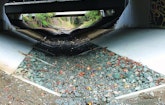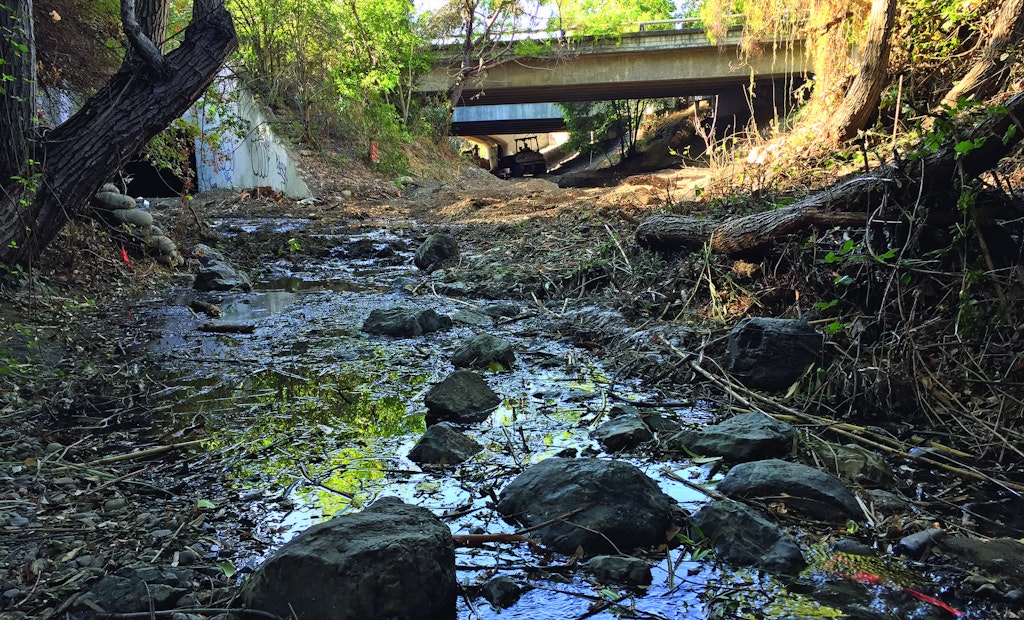Thanks to the Santa Clara Valley Water District, fish can swim upstream again to spawn and will be able to do so for many years to come.
In 2015, after 18 years of planning and collaborating with the California Department of Fish and Wildlife (CDFW), the district completed the first of three fish passage projects that will allow the endangered steelhead trout and other fish to swim under bridges and migrate to their spawning grounds.
In the Stevens Creek-Evelyn Bridge Fish Passage Project, a 10-person crew worked for nearly two months to remove two concrete weirs and excavate a low-flow channel with grade control structures. The modifications slowed down the creek’s flow so that fish can easily swim under the bridge and use a newly constructed fish ladder. To prevent future erosion and help direct the stream flow, the workers lined the channel with rocks and gravel.
Undoing damage
Stevens Creek supports a self-sustaining population of winter steelhead and had been identified by CDFW as the area’s prime steelhead habitat. Accumulated sediment and erosive flow patterns upstream and downstream of the 14-foot-wide, 469-foot-long culvert at the Evelyn Bridge diverted the flow and created dry areas in the creek that impeded steelhead migration.
Crews replaced a high-maintenance fish ladder that accumulated debris and was ineffective for migrating fish. A new weir-type ladder with a scouring pool allows continuous, unobstructed passage for steelhead. The total project cost was nearly $850,000. “The scouring pools allow the fish to rest before continuing upstream to spawn,” says Melissa Moore, associate water resources specialist for the district, based in Mountain View.
The weir-and-pool design is one of the oldest styles of fish ladders. It uses a series of small dams and pools of regular length to create a long, sloping channel for fish to travel around obstructions. Spawning habitat can be lost or damaged by culverts if sediment accumulates and alters stream flow patterns or water velocity. It’s important for the fish to reach the upper portions of the watershed because fry produced there then have access to the entire downstream watershed for rearing.
Part of the plan
The water district has made it a priority to help restore and maintain a healthy steelhead population in Santa Clara County. In 1997, a group of conservation organizations including Trout Unlimited complained that water district operations were not allowing adequate flows for the protection of fisheries in Stevens Creek and two other watersheds. As a result, the water district and CDFW collaborated to develop a fish habitat and conservation plan.
District representatives presented the plan at a general public meeting in November 2009. In 2012, county voters approved what is called the Safe, Clean Water and Natural Flood Protection Program, a 15-year program designed to match the community’s needs and values. Redesign and reconstruction of fish ladders was a part of the plan.
Improving fish passage within the Stevens Creek corridor, where summer flows are low, was considered critical to sustaining and enhancing the steelhead population. Low summer flows are caused mainly by limited releases from the 91-acre Stevens Creek Reservoir, nearly 9 miles upstream.
Steelhead typically ascend streams to the upper tributaries where conditions are most suitable for successful emergence of fry, says Moore. Juvenile steelhead may spend up to seven years in freshwater before migrating to the San Francisco Bay and Pacific Ocean to feed and mature. They can then remain at sea for up to three years before returning to freshwater to spawn. Their maximum age is about 11 years.
Benefits for all
The water district expects an annual savings of about $12,000 in operation and maintenance costs from reduced routine maintenance and debris removal at the new fish ladder. The project’s overall success will be determined by the ability to maintain adequate flow in the natural stream channel during low flows. The stream will be monitored for five years to verify the fishes’ migration success under variations in flow and annual rainfall.
Stakeholders and more than 40 citizens met earlier this year to celebrate completion of the fish passage project. Celebratory remarks and speeches were made by the mayor of Mountain View, city council members and members of various environmental and community organizations, including International Federation of Fly Fishers.
“The ribbon cutting was a real big deal to us,” says Moore. “It was the first environmental project completed under the voter-approved 15-year program.”
To commemorate the project and thank the city of Mountain View for the use of its land, the water district plans to provide an interpretive bench that will showcase information about the project and steelhead trout. The bench will be installed next to a pedestrian pathway at the Evelyn Bridge with a view of Stevens Creek.








